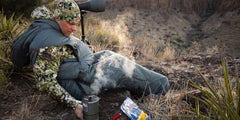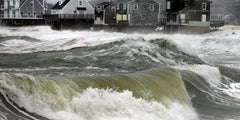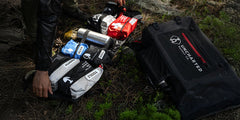
John Barklow led survival and cold weather warfare training for Navy SEAL teams for 20 years and is currently head of product development at SITKA Gear.
John is one of the top experts on survival in the world and we are honored to have him contribute to our four pillars newsletter.
For more information on John, follow him here on Instagram for his frequent educational posts. To learn more about his survival training program, Knowledge From Storms, click through here.

–
Standing knee-deep in the snow, I couldn't figure out where the blood was coming from. The Mountain goat I was skinning had been dead for an hour, and it was so cold that everything was frozen, including my hands. But the blood was fresh, so it was either mine or the animals.
Standing up and stretching my tight back, I took in the rugged, wind-swept mountains. It was late afternoon on a short Alaskan winter day, and I still had a lot of work to do and miles to ski back to my truck.
My blue fleece gloves were frosted as I rubbed my hands together, encouraging circulation. As I performed this action, rivulets of crimson blood dropped into the snow creating a stark contrast against the white ground. Like a casual observer, I squeezed my left hand into a fist and watched as blood flowed from my glove, coating the toes of my boots. Calmly, I determined I was the source of this life-giving liquid.

Medical kits are critical for our health and safety when heading into the mountains. Your kit should be built to manage common ailments and injuries like headaches, allergies, diarrhea, lacerations, sprains, and broken bones.
However, the knowledge to leverage the kit’s capabilities is just as important as the contents. Possessing tools like airways or tourniquets is not productive and possibly more harmful if you aren’t trained to use them properly.
You must know the A, B, C's of first aid, the signs and symptoms of cold & heat injuries, the effects of altitude illness, and the course of action to take if any of these present themselves in the field.

You and your partners should take a basic first aid class or Wilderness First Responder course, keeping current. These courses help best leverage the contents of your med kit and its capabilities. But you can’t build a med kit for every contingency, and to do so creates a kit that burdens you and creates excuses to leave it at home. Training with and using your kit in the field will inform this reality, and the kit will slowly evolve into something workable. Just be sure and replenish what you use and check for expired meds and supplies before each season.

I’ve found the best place to carry the med kit is in the Possibles Pouch. This way, it’s with other critical gear packaged for contingencies and is not left behind when dropping your pack to go on a stalk. Simply grab the Possible Pouch, strap it on, and go.
Here are a few links to my Knowledge From Storms youtube channel providing a more detailed explanation of Possibles Pouches and Survival Kits.
Survival Kits 1
Survival Kits 2
Survival Kits 3
Each person needs to carry their own med kit and be self-sufficient in case of separation from the group, like going on a stalk or heading to a water source. The kit also needs to be personalized to individual needs, like prescriptions, allergies, or personal medical issues. If a partner goes into anaphylactic shock from a bee sting or an Asthma attack, they need their Epi-Pen or inhaler in their personal kit.
The med kit should be mandatory in your loadout and always be in your pack whether you’re headed out for the day or a month. It’s cheap insurance. Hopefully, you’ll never need it for anything other than minor issues, but if the day comes you need its full capabilities, you’ll be glad you packed it.



